Financial Accounting Report: Financial Analysis for Decision Making
VerifiedAdded on 2023/01/13
|9
|1848
|91
Report
AI Summary
This report, prepared as part of a financial accounting assignment, analyzes the financial statements of Glaxo Smithkline PLC (GSK PLC) to assess its financial performance. The report focuses on the calculation and interpretation of Earnings Before Interest and Taxes (EBIT) and Earnings Before Interest, Taxes, Depreciation, and Amortization (EBITDA) margins, highlighting their usefulness in financial analysis and decision-making. The analysis includes a comparison of EBIT and EBITDA figures over multiple years, offering insights into the company's operating earnings and investment returns. Furthermore, the report explores the criteria for revenue recognition, referencing International Financial Reporting Standard 15, and the systematic application of depreciation in asset valuation. The conclusion emphasizes the importance of EBIT and EBITDA as key metrics for investors, providing a more accurate view of a company's production performance. The report is designed for a business analyst role, aiding in investment evaluations.

FINANCIAL ACCOUNTING
FOR MANAGERIAL DECISION
MAKING
FOR MANAGERIAL DECISION
MAKING
Paraphrase This Document
Need a fresh take? Get an instant paraphrase of this document with our AI Paraphraser
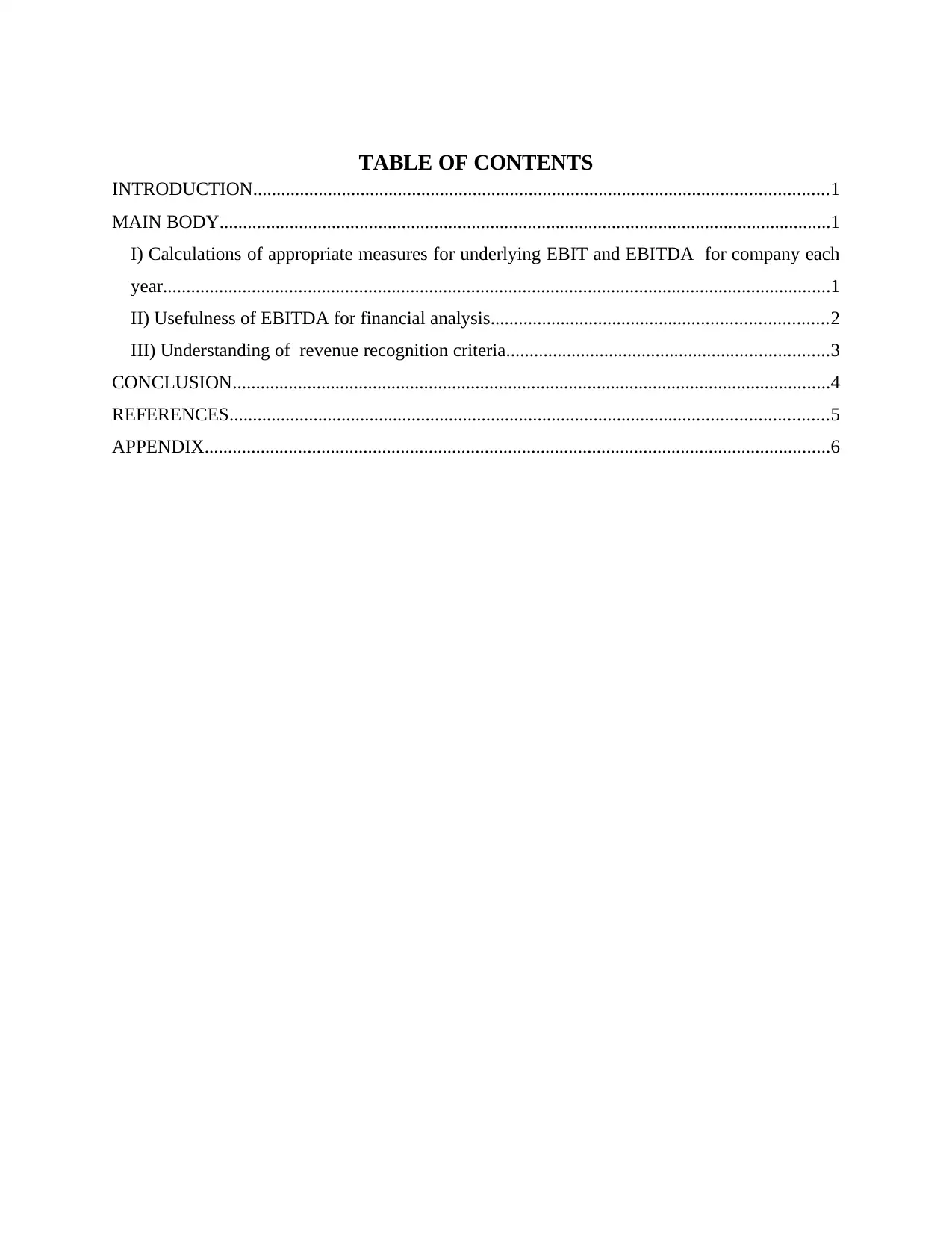
TABLE OF CONTENTS
INTRODUCTION...........................................................................................................................1
MAIN BODY...................................................................................................................................1
I) Calculations of appropriate measures for underlying EBIT and EBITDA for company each
year...............................................................................................................................................1
II) Usefulness of EBITDA for financial analysis........................................................................2
III) Understanding of revenue recognition criteria.....................................................................3
CONCLUSION................................................................................................................................4
REFERENCES................................................................................................................................5
APPENDIX......................................................................................................................................6
INTRODUCTION...........................................................................................................................1
MAIN BODY...................................................................................................................................1
I) Calculations of appropriate measures for underlying EBIT and EBITDA for company each
year...............................................................................................................................................1
II) Usefulness of EBITDA for financial analysis........................................................................2
III) Understanding of revenue recognition criteria.....................................................................3
CONCLUSION................................................................................................................................4
REFERENCES................................................................................................................................5
APPENDIX......................................................................................................................................6
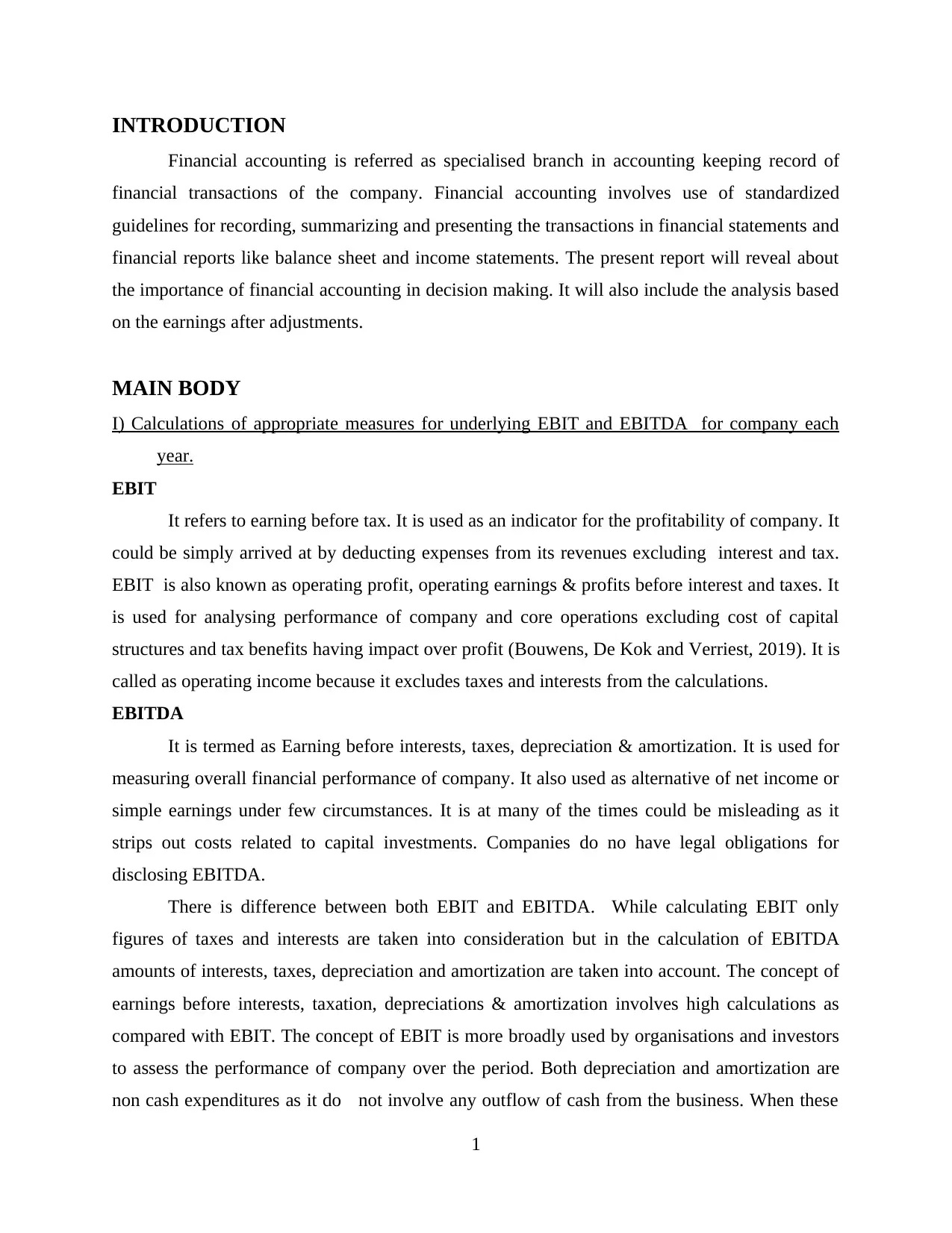
INTRODUCTION
Financial accounting is referred as specialised branch in accounting keeping record of
financial transactions of the company. Financial accounting involves use of standardized
guidelines for recording, summarizing and presenting the transactions in financial statements and
financial reports like balance sheet and income statements. The present report will reveal about
the importance of financial accounting in decision making. It will also include the analysis based
on the earnings after adjustments.
MAIN BODY
I) Calculations of appropriate measures for underlying EBIT and EBITDA for company each
year.
EBIT
It refers to earning before tax. It is used as an indicator for the profitability of company. It
could be simply arrived at by deducting expenses from its revenues excluding interest and tax.
EBIT is also known as operating profit, operating earnings & profits before interest and taxes. It
is used for analysing performance of company and core operations excluding cost of capital
structures and tax benefits having impact over profit (Bouwens, De Kok and Verriest, 2019). It is
called as operating income because it excludes taxes and interests from the calculations.
EBITDA
It is termed as Earning before interests, taxes, depreciation & amortization. It is used for
measuring overall financial performance of company. It also used as alternative of net income or
simple earnings under few circumstances. It is at many of the times could be misleading as it
strips out costs related to capital investments. Companies do no have legal obligations for
disclosing EBITDA.
There is difference between both EBIT and EBITDA. While calculating EBIT only
figures of taxes and interests are taken into consideration but in the calculation of EBITDA
amounts of interests, taxes, depreciation and amortization are taken into account. The concept of
earnings before interests, taxation, depreciations & amortization involves high calculations as
compared with EBIT. The concept of EBIT is more broadly used by organisations and investors
to assess the performance of company over the period. Both depreciation and amortization are
non cash expenditures as it do not involve any outflow of cash from the business. When these
1
Financial accounting is referred as specialised branch in accounting keeping record of
financial transactions of the company. Financial accounting involves use of standardized
guidelines for recording, summarizing and presenting the transactions in financial statements and
financial reports like balance sheet and income statements. The present report will reveal about
the importance of financial accounting in decision making. It will also include the analysis based
on the earnings after adjustments.
MAIN BODY
I) Calculations of appropriate measures for underlying EBIT and EBITDA for company each
year.
EBIT
It refers to earning before tax. It is used as an indicator for the profitability of company. It
could be simply arrived at by deducting expenses from its revenues excluding interest and tax.
EBIT is also known as operating profit, operating earnings & profits before interest and taxes. It
is used for analysing performance of company and core operations excluding cost of capital
structures and tax benefits having impact over profit (Bouwens, De Kok and Verriest, 2019). It is
called as operating income because it excludes taxes and interests from the calculations.
EBITDA
It is termed as Earning before interests, taxes, depreciation & amortization. It is used for
measuring overall financial performance of company. It also used as alternative of net income or
simple earnings under few circumstances. It is at many of the times could be misleading as it
strips out costs related to capital investments. Companies do no have legal obligations for
disclosing EBITDA.
There is difference between both EBIT and EBITDA. While calculating EBIT only
figures of taxes and interests are taken into consideration but in the calculation of EBITDA
amounts of interests, taxes, depreciation and amortization are taken into account. The concept of
earnings before interests, taxation, depreciations & amortization involves high calculations as
compared with EBIT. The concept of EBIT is more broadly used by organisations and investors
to assess the performance of company over the period. Both depreciation and amortization are
non cash expenditures as it do not involve any outflow of cash from the business. When these
1
⊘ This is a preview!⊘
Do you want full access?
Subscribe today to unlock all pages.

Trusted by 1+ million students worldwide
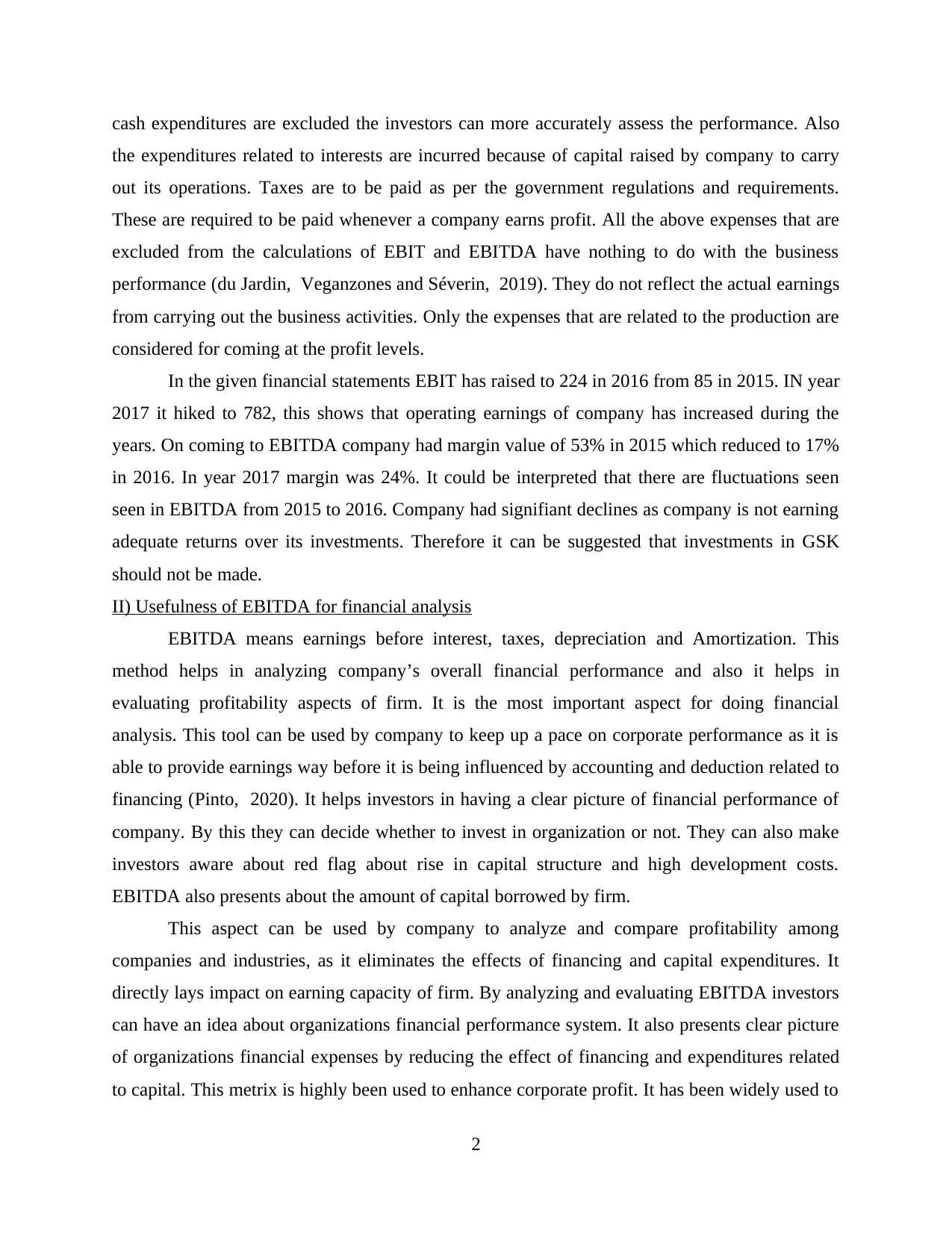
cash expenditures are excluded the investors can more accurately assess the performance. Also
the expenditures related to interests are incurred because of capital raised by company to carry
out its operations. Taxes are to be paid as per the government regulations and requirements.
These are required to be paid whenever a company earns profit. All the above expenses that are
excluded from the calculations of EBIT and EBITDA have nothing to do with the business
performance (du Jardin, Veganzones and Séverin, 2019). They do not reflect the actual earnings
from carrying out the business activities. Only the expenses that are related to the production are
considered for coming at the profit levels.
In the given financial statements EBIT has raised to 224 in 2016 from 85 in 2015. IN year
2017 it hiked to 782, this shows that operating earnings of company has increased during the
years. On coming to EBITDA company had margin value of 53% in 2015 which reduced to 17%
in 2016. In year 2017 margin was 24%. It could be interpreted that there are fluctuations seen
seen in EBITDA from 2015 to 2016. Company had signifiant declines as company is not earning
adequate returns over its investments. Therefore it can be suggested that investments in GSK
should not be made.
II) Usefulness of EBITDA for financial analysis
EBITDA means earnings before interest, taxes, depreciation and Amortization. This
method helps in analyzing company’s overall financial performance and also it helps in
evaluating profitability aspects of firm. It is the most important aspect for doing financial
analysis. This tool can be used by company to keep up a pace on corporate performance as it is
able to provide earnings way before it is being influenced by accounting and deduction related to
financing (Pinto, 2020). It helps investors in having a clear picture of financial performance of
company. By this they can decide whether to invest in organization or not. They can also make
investors aware about red flag about rise in capital structure and high development costs.
EBITDA also presents about the amount of capital borrowed by firm.
This aspect can be used by company to analyze and compare profitability among
companies and industries, as it eliminates the effects of financing and capital expenditures. It
directly lays impact on earning capacity of firm. By analyzing and evaluating EBITDA investors
can have an idea about organizations financial performance system. It also presents clear picture
of organizations financial expenses by reducing the effect of financing and expenditures related
to capital. This metrix is highly been used to enhance corporate profit. It has been widely used to
2
the expenditures related to interests are incurred because of capital raised by company to carry
out its operations. Taxes are to be paid as per the government regulations and requirements.
These are required to be paid whenever a company earns profit. All the above expenses that are
excluded from the calculations of EBIT and EBITDA have nothing to do with the business
performance (du Jardin, Veganzones and Séverin, 2019). They do not reflect the actual earnings
from carrying out the business activities. Only the expenses that are related to the production are
considered for coming at the profit levels.
In the given financial statements EBIT has raised to 224 in 2016 from 85 in 2015. IN year
2017 it hiked to 782, this shows that operating earnings of company has increased during the
years. On coming to EBITDA company had margin value of 53% in 2015 which reduced to 17%
in 2016. In year 2017 margin was 24%. It could be interpreted that there are fluctuations seen
seen in EBITDA from 2015 to 2016. Company had signifiant declines as company is not earning
adequate returns over its investments. Therefore it can be suggested that investments in GSK
should not be made.
II) Usefulness of EBITDA for financial analysis
EBITDA means earnings before interest, taxes, depreciation and Amortization. This
method helps in analyzing company’s overall financial performance and also it helps in
evaluating profitability aspects of firm. It is the most important aspect for doing financial
analysis. This tool can be used by company to keep up a pace on corporate performance as it is
able to provide earnings way before it is being influenced by accounting and deduction related to
financing (Pinto, 2020). It helps investors in having a clear picture of financial performance of
company. By this they can decide whether to invest in organization or not. They can also make
investors aware about red flag about rise in capital structure and high development costs.
EBITDA also presents about the amount of capital borrowed by firm.
This aspect can be used by company to analyze and compare profitability among
companies and industries, as it eliminates the effects of financing and capital expenditures. It
directly lays impact on earning capacity of firm. By analyzing and evaluating EBITDA investors
can have an idea about organizations financial performance system. It also presents clear picture
of organizations financial expenses by reducing the effect of financing and expenditures related
to capital. This metrix is highly been used to enhance corporate profit. It has been widely used to
2
Paraphrase This Document
Need a fresh take? Get an instant paraphrase of this document with our AI Paraphraser
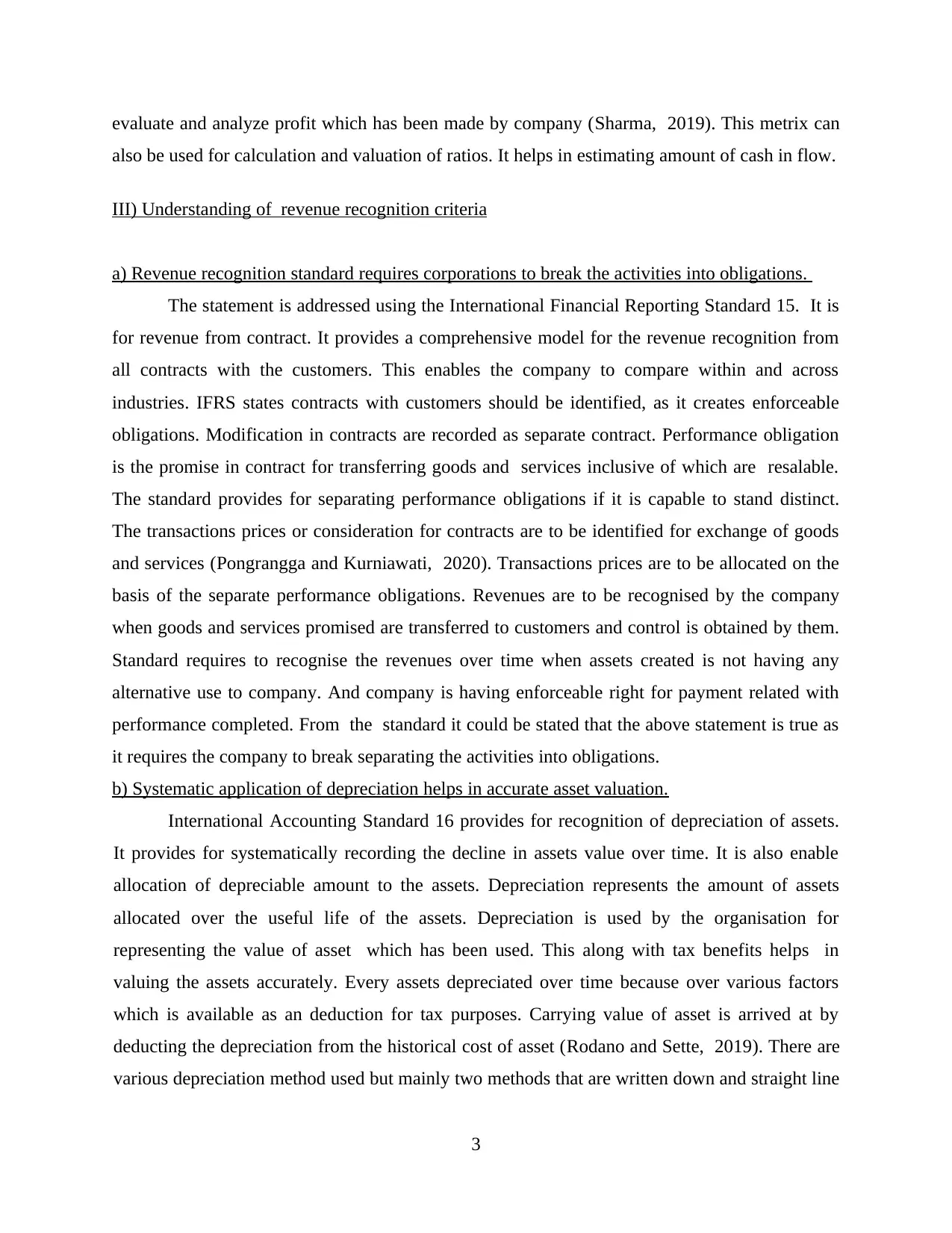
evaluate and analyze profit which has been made by company (Sharma, 2019). This metrix can
also be used for calculation and valuation of ratios. It helps in estimating amount of cash in flow.
III) Understanding of revenue recognition criteria
a) Revenue recognition standard requires corporations to break the activities into obligations.
The statement is addressed using the International Financial Reporting Standard 15. It is
for revenue from contract. It provides a comprehensive model for the revenue recognition from
all contracts with the customers. This enables the company to compare within and across
industries. IFRS states contracts with customers should be identified, as it creates enforceable
obligations. Modification in contracts are recorded as separate contract. Performance obligation
is the promise in contract for transferring goods and services inclusive of which are resalable.
The standard provides for separating performance obligations if it is capable to stand distinct.
The transactions prices or consideration for contracts are to be identified for exchange of goods
and services (Pongrangga and Kurniawati, 2020). Transactions prices are to be allocated on the
basis of the separate performance obligations. Revenues are to be recognised by the company
when goods and services promised are transferred to customers and control is obtained by them.
Standard requires to recognise the revenues over time when assets created is not having any
alternative use to company. And company is having enforceable right for payment related with
performance completed. From the standard it could be stated that the above statement is true as
it requires the company to break separating the activities into obligations.
b) Systematic application of depreciation helps in accurate asset valuation.
International Accounting Standard 16 provides for recognition of depreciation of assets.
It provides for systematically recording the decline in assets value over time. It is also enable
allocation of depreciable amount to the assets. Depreciation represents the amount of assets
allocated over the useful life of the assets. Depreciation is used by the organisation for
representing the value of asset which has been used. This along with tax benefits helps in
valuing the assets accurately. Every assets depreciated over time because over various factors
which is available as an deduction for tax purposes. Carrying value of asset is arrived at by
deducting the depreciation from the historical cost of asset (Rodano and Sette, 2019). There are
various depreciation method used but mainly two methods that are written down and straight line
3
also be used for calculation and valuation of ratios. It helps in estimating amount of cash in flow.
III) Understanding of revenue recognition criteria
a) Revenue recognition standard requires corporations to break the activities into obligations.
The statement is addressed using the International Financial Reporting Standard 15. It is
for revenue from contract. It provides a comprehensive model for the revenue recognition from
all contracts with the customers. This enables the company to compare within and across
industries. IFRS states contracts with customers should be identified, as it creates enforceable
obligations. Modification in contracts are recorded as separate contract. Performance obligation
is the promise in contract for transferring goods and services inclusive of which are resalable.
The standard provides for separating performance obligations if it is capable to stand distinct.
The transactions prices or consideration for contracts are to be identified for exchange of goods
and services (Pongrangga and Kurniawati, 2020). Transactions prices are to be allocated on the
basis of the separate performance obligations. Revenues are to be recognised by the company
when goods and services promised are transferred to customers and control is obtained by them.
Standard requires to recognise the revenues over time when assets created is not having any
alternative use to company. And company is having enforceable right for payment related with
performance completed. From the standard it could be stated that the above statement is true as
it requires the company to break separating the activities into obligations.
b) Systematic application of depreciation helps in accurate asset valuation.
International Accounting Standard 16 provides for recognition of depreciation of assets.
It provides for systematically recording the decline in assets value over time. It is also enable
allocation of depreciable amount to the assets. Depreciation represents the amount of assets
allocated over the useful life of the assets. Depreciation is used by the organisation for
representing the value of asset which has been used. This along with tax benefits helps in
valuing the assets accurately. Every assets depreciated over time because over various factors
which is available as an deduction for tax purposes. Carrying value of asset is arrived at by
deducting the depreciation from the historical cost of asset (Rodano and Sette, 2019). There are
various depreciation method used but mainly two methods that are written down and straight line
3
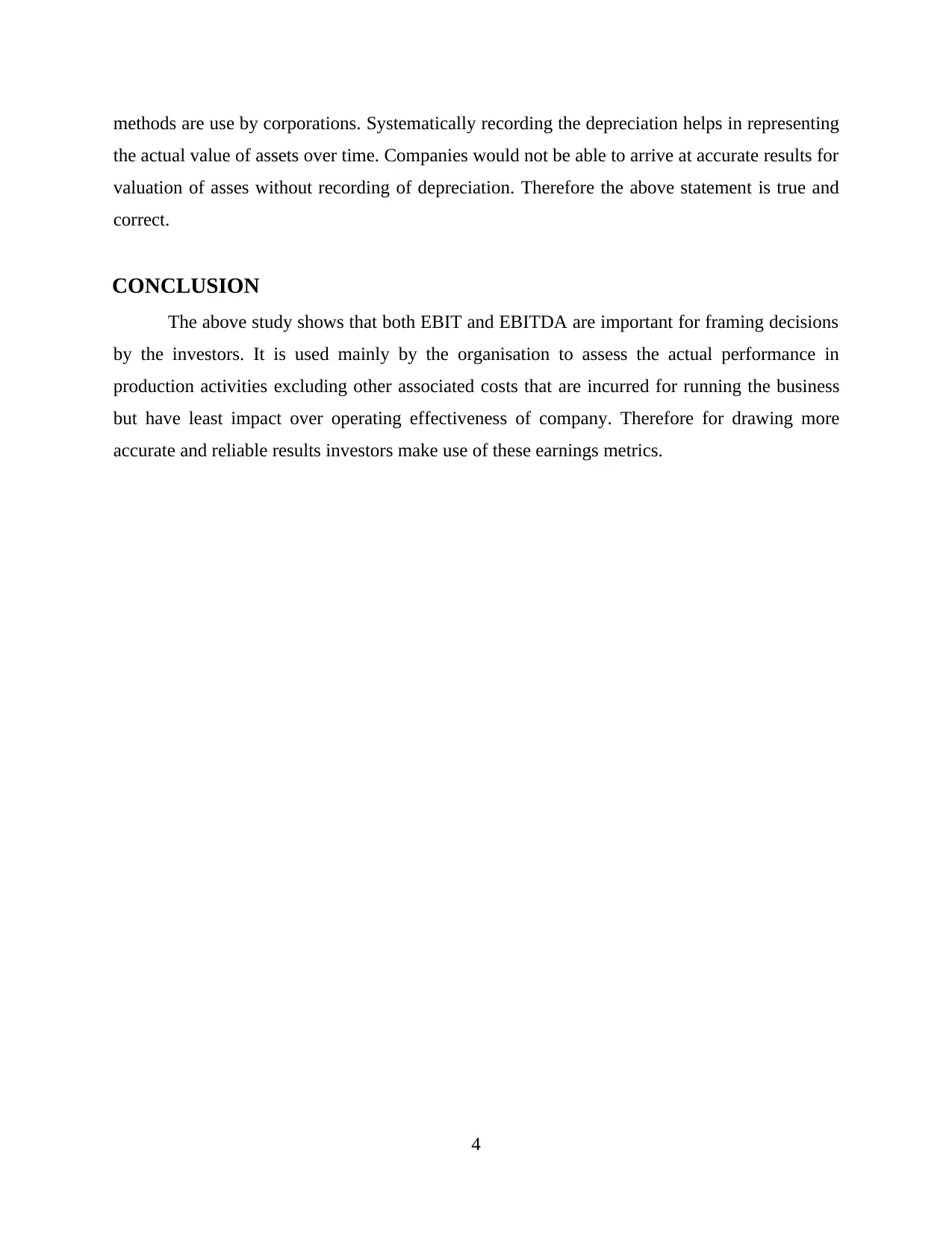
methods are use by corporations. Systematically recording the depreciation helps in representing
the actual value of assets over time. Companies would not be able to arrive at accurate results for
valuation of asses without recording of depreciation. Therefore the above statement is true and
correct.
CONCLUSION
The above study shows that both EBIT and EBITDA are important for framing decisions
by the investors. It is used mainly by the organisation to assess the actual performance in
production activities excluding other associated costs that are incurred for running the business
but have least impact over operating effectiveness of company. Therefore for drawing more
accurate and reliable results investors make use of these earnings metrics.
4
the actual value of assets over time. Companies would not be able to arrive at accurate results for
valuation of asses without recording of depreciation. Therefore the above statement is true and
correct.
CONCLUSION
The above study shows that both EBIT and EBITDA are important for framing decisions
by the investors. It is used mainly by the organisation to assess the actual performance in
production activities excluding other associated costs that are incurred for running the business
but have least impact over operating effectiveness of company. Therefore for drawing more
accurate and reliable results investors make use of these earnings metrics.
4
⊘ This is a preview!⊘
Do you want full access?
Subscribe today to unlock all pages.

Trusted by 1+ million students worldwide
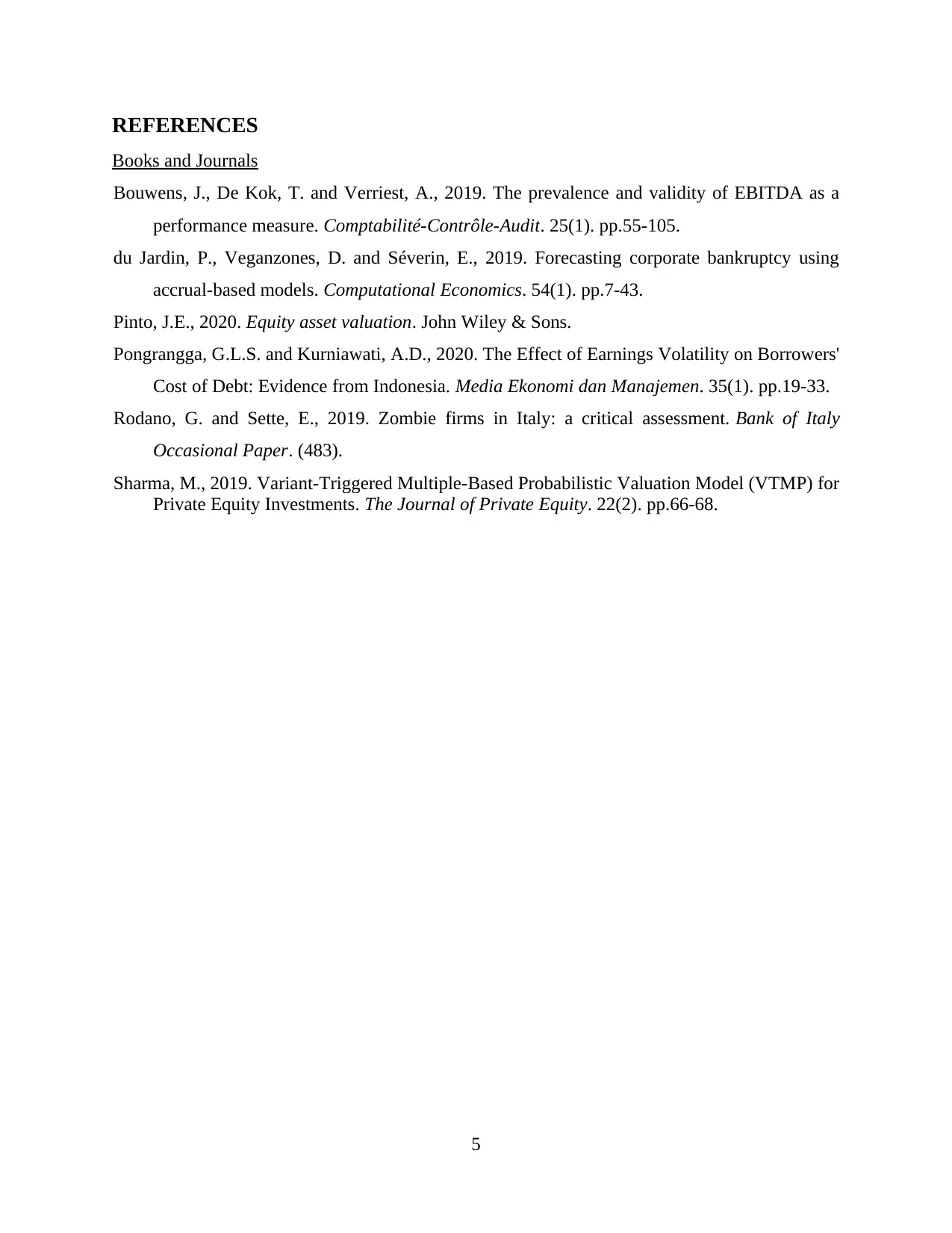
REFERENCES
Books and Journals
Bouwens, J., De Kok, T. and Verriest, A., 2019. The prevalence and validity of EBITDA as a
performance measure. Comptabilité-Contrôle-Audit. 25(1). pp.55-105.
du Jardin, P., Veganzones, D. and Séverin, E., 2019. Forecasting corporate bankruptcy using
accrual-based models. Computational Economics. 54(1). pp.7-43.
Pinto, J.E., 2020. Equity asset valuation. John Wiley & Sons.
Pongrangga, G.L.S. and Kurniawati, A.D., 2020. The Effect of Earnings Volatility on Borrowers'
Cost of Debt: Evidence from Indonesia. Media Ekonomi dan Manajemen. 35(1). pp.19-33.
Rodano, G. and Sette, E., 2019. Zombie firms in Italy: a critical assessment. Bank of Italy
Occasional Paper. (483).
Sharma, M., 2019. Variant-Triggered Multiple-Based Probabilistic Valuation Model (VTMP) for
Private Equity Investments. The Journal of Private Equity. 22(2). pp.66-68.
5
Books and Journals
Bouwens, J., De Kok, T. and Verriest, A., 2019. The prevalence and validity of EBITDA as a
performance measure. Comptabilité-Contrôle-Audit. 25(1). pp.55-105.
du Jardin, P., Veganzones, D. and Séverin, E., 2019. Forecasting corporate bankruptcy using
accrual-based models. Computational Economics. 54(1). pp.7-43.
Pinto, J.E., 2020. Equity asset valuation. John Wiley & Sons.
Pongrangga, G.L.S. and Kurniawati, A.D., 2020. The Effect of Earnings Volatility on Borrowers'
Cost of Debt: Evidence from Indonesia. Media Ekonomi dan Manajemen. 35(1). pp.19-33.
Rodano, G. and Sette, E., 2019. Zombie firms in Italy: a critical assessment. Bank of Italy
Occasional Paper. (483).
Sharma, M., 2019. Variant-Triggered Multiple-Based Probabilistic Valuation Model (VTMP) for
Private Equity Investments. The Journal of Private Equity. 22(2). pp.66-68.
5
Paraphrase This Document
Need a fresh take? Get an instant paraphrase of this document with our AI Paraphraser
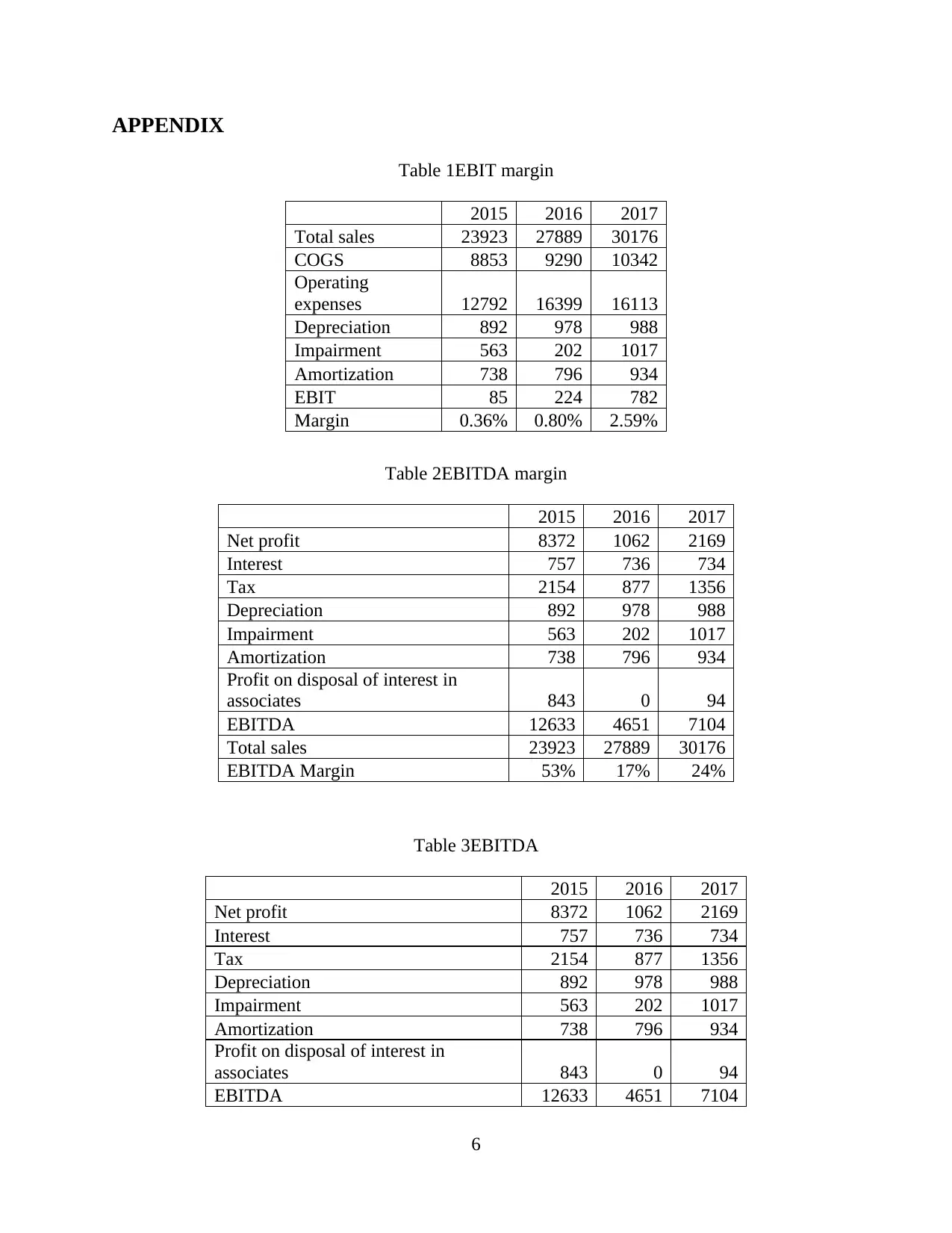
APPENDIX
Table 1EBIT margin
2015 2016 2017
Total sales 23923 27889 30176
COGS 8853 9290 10342
Operating
expenses 12792 16399 16113
Depreciation 892 978 988
Impairment 563 202 1017
Amortization 738 796 934
EBIT 85 224 782
Margin 0.36% 0.80% 2.59%
Table 2EBITDA margin
2015 2016 2017
Net profit 8372 1062 2169
Interest 757 736 734
Tax 2154 877 1356
Depreciation 892 978 988
Impairment 563 202 1017
Amortization 738 796 934
Profit on disposal of interest in
associates 843 0 94
EBITDA 12633 4651 7104
Total sales 23923 27889 30176
EBITDA Margin 53% 17% 24%
Table 3EBITDA
2015 2016 2017
Net profit 8372 1062 2169
Interest 757 736 734
Tax 2154 877 1356
Depreciation 892 978 988
Impairment 563 202 1017
Amortization 738 796 934
Profit on disposal of interest in
associates 843 0 94
EBITDA 12633 4651 7104
6
Table 1EBIT margin
2015 2016 2017
Total sales 23923 27889 30176
COGS 8853 9290 10342
Operating
expenses 12792 16399 16113
Depreciation 892 978 988
Impairment 563 202 1017
Amortization 738 796 934
EBIT 85 224 782
Margin 0.36% 0.80% 2.59%
Table 2EBITDA margin
2015 2016 2017
Net profit 8372 1062 2169
Interest 757 736 734
Tax 2154 877 1356
Depreciation 892 978 988
Impairment 563 202 1017
Amortization 738 796 934
Profit on disposal of interest in
associates 843 0 94
EBITDA 12633 4651 7104
Total sales 23923 27889 30176
EBITDA Margin 53% 17% 24%
Table 3EBITDA
2015 2016 2017
Net profit 8372 1062 2169
Interest 757 736 734
Tax 2154 877 1356
Depreciation 892 978 988
Impairment 563 202 1017
Amortization 738 796 934
Profit on disposal of interest in
associates 843 0 94
EBITDA 12633 4651 7104
6
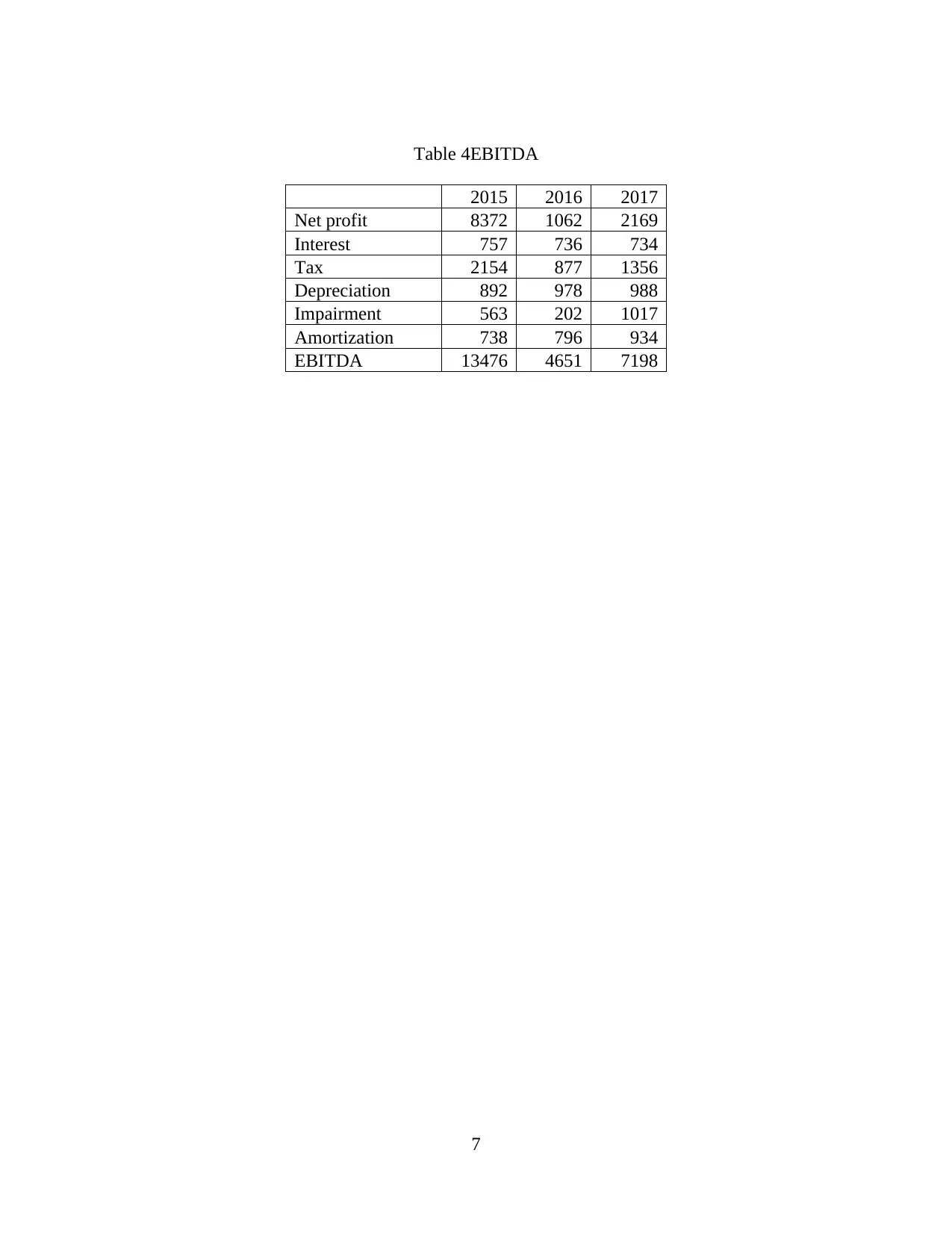
Table 4EBITDA
2015 2016 2017
Net profit 8372 1062 2169
Interest 757 736 734
Tax 2154 877 1356
Depreciation 892 978 988
Impairment 563 202 1017
Amortization 738 796 934
EBITDA 13476 4651 7198
7
2015 2016 2017
Net profit 8372 1062 2169
Interest 757 736 734
Tax 2154 877 1356
Depreciation 892 978 988
Impairment 563 202 1017
Amortization 738 796 934
EBITDA 13476 4651 7198
7
⊘ This is a preview!⊘
Do you want full access?
Subscribe today to unlock all pages.

Trusted by 1+ million students worldwide
1 out of 9
Related Documents
Your All-in-One AI-Powered Toolkit for Academic Success.
+13062052269
info@desklib.com
Available 24*7 on WhatsApp / Email
![[object Object]](/_next/static/media/star-bottom.7253800d.svg)
Unlock your academic potential
Copyright © 2020–2025 A2Z Services. All Rights Reserved. Developed and managed by ZUCOL.





